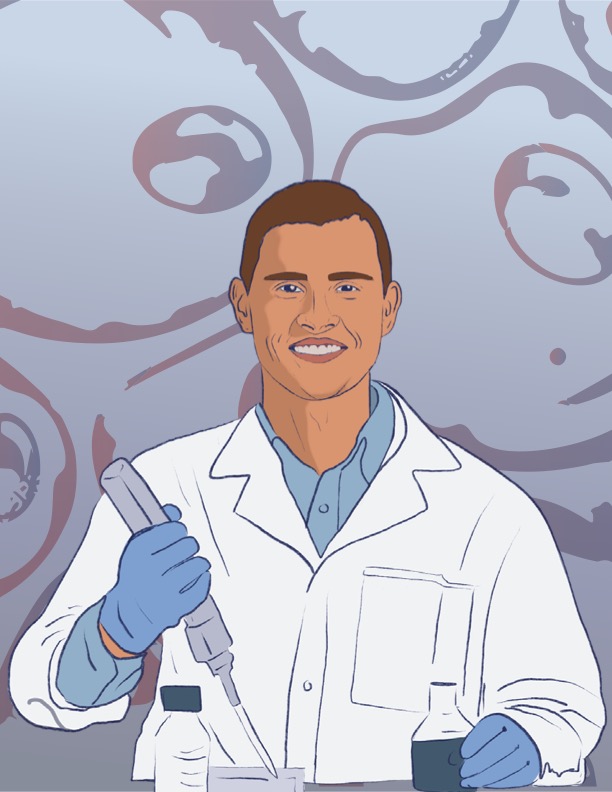
Therapies that use engineered cells to treat diseases, infections and chronic illnesses are opening doors to solutions for longstanding medical challenges. Lukasz Bugaj, Assistant Professor in Bioengineering, has been awarded a National Science Foundation CAREER Award for research that may be key to opening some of those doors.
Such cellular therapies take advantage of the complex molecular mechanisms that cells naturally use to interact with one another, enabling them to be more precise and less toxic than traditional pharmaceutical drugs, which are based on simpler small molecules. Cellular therapies that use engineered immune system cells, for example, have recently been shown to be highly successful in treating certain cancers and protecting against viral infections.
However, there is still a need to further fine-tune the behavior of cells in these targeted therapies. Bugaj and colleagues are addressing that need by developing new ways to communicate with engineered cells once they are in the body, such as turning molecular events on and off at specific times.
The research team recently discovered that both temperature and light can act as triggers of a specific fungal protein, dynamically controlling its location within a mammalian cell. By using light or temperature to instruct that protein to migrate toward or away from the cell’s membrane, Bugaj and his colleagues showed how it could serve as a key component in controlling the behavior of human cells.
The aim of the initial study was to develop probes that would take advantage of the light-responsive properties of the protein and to characterize its unique sensitivity to both light and temperature. Now, funded by the CAREER Award, they plan to research how to control it with only temperature as an input.
“We are looking for ways to talk to the cells in the body,” says Bugaj. “We can use light to communicate very precisely with cells, but light can only penetrate through a few millimeters of skin. When we discovered that this protein responds to both light and temperature, we thought we could modify it for purely thermal control, which would provide a new method to communicate with cells deeper in the body.”
In some of their first experiments, they accomplished this. The team took the light-sensing apparatus of the protein and disabled it, leaving only temperature as a stimulus. However, since the protein originates from a fungus that thrives in colder temperatures, the temperature at which it can be toggled is currently too low for use in mammalian cells. Adapting its thermal control mechanism to mammalian temperature ranges is one current challenge.
“The protein is currently switched on at around 32 degrees Celsius,” says Bugaj. “Above that, temperature no longer works as a regulator. If we want to use this for protein control in the human body, we will first have to change its switching temperature to be above 37 degrees Celsius, our normal body temperature.”
The three goals of the proposed research include characterizing the temperature dependence of the engineered protein, changing that dependence to allow the protein to be controlled by temperatures relevant to mammalian body temperatures, and then using it to control posttranslational modifications or gene expression in specific mammalian cells.
“If we can get to the point where we can use heat to tell cells what to do and when to do it, we can improve the specificity of targeted cellular therapies, making them less toxic and more effective,” says Bugaj. “This can be applied for safer cell therapies but also beyond, for example to optimize biomanufacturing or even to build next-generation engineered cells that autonomously sense pathological temperature and execute a therapeutic response.”
The research itself fits into current clinical capacity. Non-invasive, precise heating of patient tissues can already be achieved in the clinic through technology like focused ultrasound, which can heat tissues with high precision in three dimensions. Further, animal models already exist to test the effectiveness of thermally controlled cells.
As cellular therapy becomes a standard form of treatment, the need to educate people on the topic will increase. The CAREER Award funds Bugaj’s efforts in education and outreach of the subject matter through his proposed hands-on educational module for Philadelphia high school students.
“I want to make the concept of cell engineering interesting, fun and tangible,” says Bugaj. “In our module we will introduce the concept of cells as computers, programmable and buildable. Students are increasingly familiar with how to program computers. I want to show them that now we can do very similar things but with biology, and we can do this to solve some of our biggest challenges.
“As part of this module,” he continues, “the students will build simple battery-operated circuits that they can turn on and off with light and temperature to really drive the analogy home. My hope is to expose the students to the possibilities of modern biotechnology and really strengthen the connection between circuits, programming, and cell engineering.”
